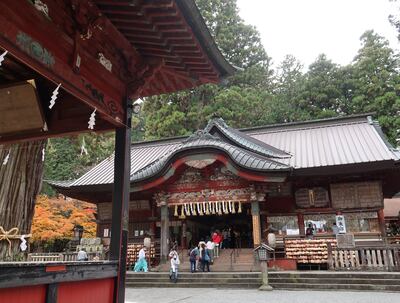Before setting out to climb Japan’s most famous peak, it never hurts to pay your respects to the gods of the mountain. These are, after all, the deities locals believe can position a rock on Mount Fuji so that it twists an unwary hiker’s ankle or form a ring of cloud around the peak so dense that the track and your climbing partners simply disappear.
There are four routes to the top of the slumbering 3,776-metre volcano, a Unesco World Heritage Site since 2013, that is as quintessentially Japanese as geishas and cherry blossoms.
I would suggest taking the Yoshida Trail, which traditionally starts at the Kitaguchi Hongu Fuji Sengen Shrine. Set amid towering cedar trees, the shrine is one of about 1,300 Asama shrines that are rooted in the worship of volcanoes in general, but Mount Fuji, in particular. Asama shrines are dedicated to Konohanasakuya-hima, or the “cherry blossom princess”, the goddess of all volcanic peaks in Japanese mythology.

A much smaller version of the shrine is said to have been founded around the year 100, and dedicated to the goddess in 788 in an effort to placate the angry spirits of the mountain and reduce the frequent eruptions and devastating lava flows. The imposing main hall dates from 1615 and faces an elevated stage where traditional music is performed on festival days.
Thick shimenawa ropes of rice straw encircle the tallest trees in the compound, festooned with paper streamers.
To pray for safety on the coming journey, approach the shrine and tug hard on the rope to ring the bell, which is meant to ensure the gods are listening. Throw a few coins in the offering box, clap your hands, bow your head and ask for the gods’ protection. You are now ready to set out.
The shrine used to be the starting point of the Yoshida Trail, but a road has been constructed for buses heading to the Fuji-Subaru Line Fifth Station, at an altitude of 2,305 metres.
It is here that the Yamanashi prefectural government is expected to start collecting tolls from this summer, with the sum of 2,000 Japanese yen ($13.41) expected to be agreed in the coming weeks as the appropriate figure. The money raised will go to improving the path to the top of the mountain, renovating public toilets and the construction of emergency shelters for use in the event of an eruption.
The local government is also planning to impose a limit of 4,000 hikers a day on the route in an effort to reduce congestion during the 70-day climbing season, which traditionally starts on July 1.

The fifth station is the place to purchase a wooden hiking stave. Top tip: don't forget to have it stamped at each of the mountain huts you pass on the ascent.
Many hikers set off in the late afternoon or early evening for the 6.8-kilometre hike, which typically takes between five and seven hours, so they arrive at the rim of the crater just as the sun is rising.
The trail is clearly marked and ascends gradually through a pine forest, which quickly gives way to scrubby bushland with increasingly frequent patches of bare rock and scree. As the trees thin out, the wind can become more forceful, with gusts around the flanks of the mountain. My boots kick up dust that eddies around my ankles, as the path becomes steeper until it begins to switch back to noticeably sharper inclines.
There are a number of “stations” on the route, spread out about 60 to 90 minutes’ walk apart, complete with toilets and vending machines. The mountain huts also provide short-stay accommodation and are recommended for anyone concerned about acclimatising to the altitude. Make a reservation in advance as they are often busy, but pull off your boots at the door, grab a tatami mat for a couple of hours’ shut-eye and you will be refreshed for the final push to the summit.
Climbing by the light of a head torch can be a little monotonous, but there is a great camaraderie among the different groups as they pass each other while taking breaks. The path gets narrower the closer we get to the top and there are patches of luminescent ice on both sides of the trail. The air is noticeably thinner.
The goal is marked by a red-painted “torii” gateway and we take the final few strides. And just in time. Looking to the east, the huge orange disc of the sun rises over the edge of the world and starts its own ascent. The temperature climbs and the clouds start to burn off. It is time for photographs and to peer down into the maw of the dormant volcano, while those who still have reserves of energy set out on the 3km circumnavigation of the crater.

For most, however, it is time to commence the return journey before leg muscles start to tighten.
An ascent of Japan’s most famous mountain is on many visitors’ bucket lists, but it should not be undertaken lightly. Wear appropriate footwear and do not make the mistake of thinking the humidity and heat common at the start of the trek will last. Temperatures at the peak can be below 0°C, even at the height of summer, and the wind can be bitter.
Unless you're an experienced hiker, it is recommended that you join a guided hike with a company such as Fuji Mountain Guides.
Whether you head up with friends, as a guided group or alone, just make sure you don't forget to pay respects to the gods first.
